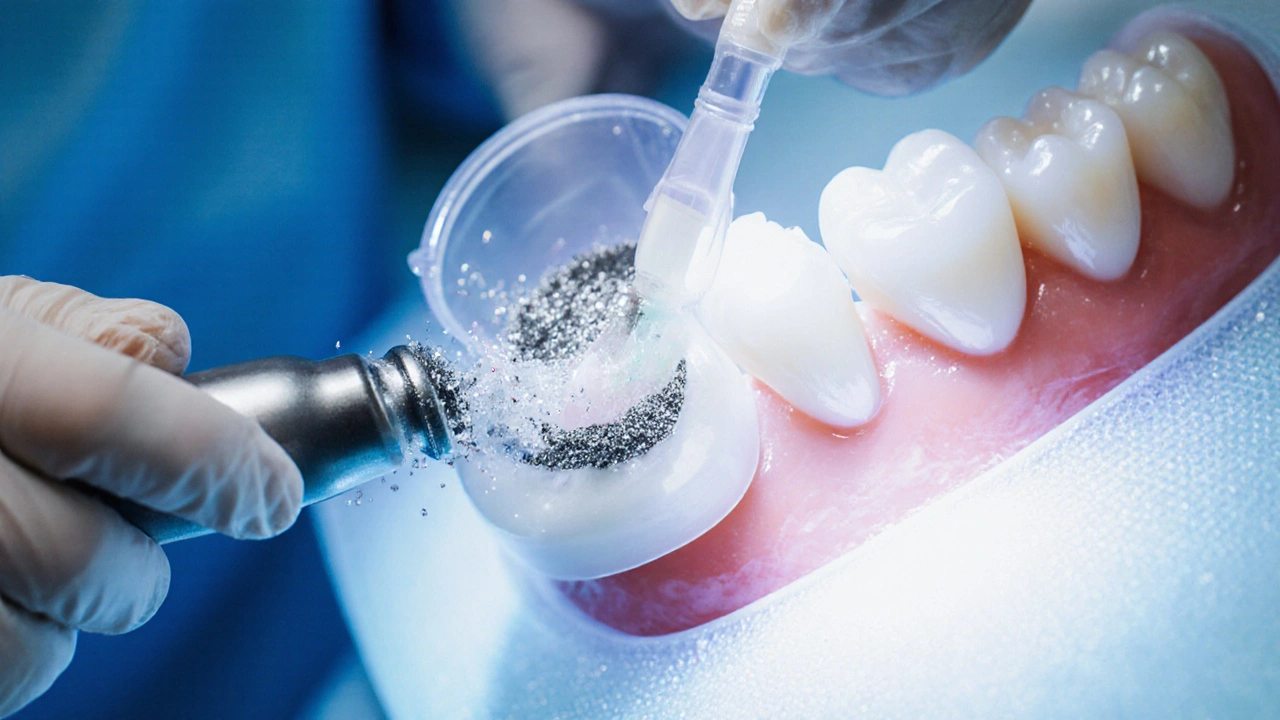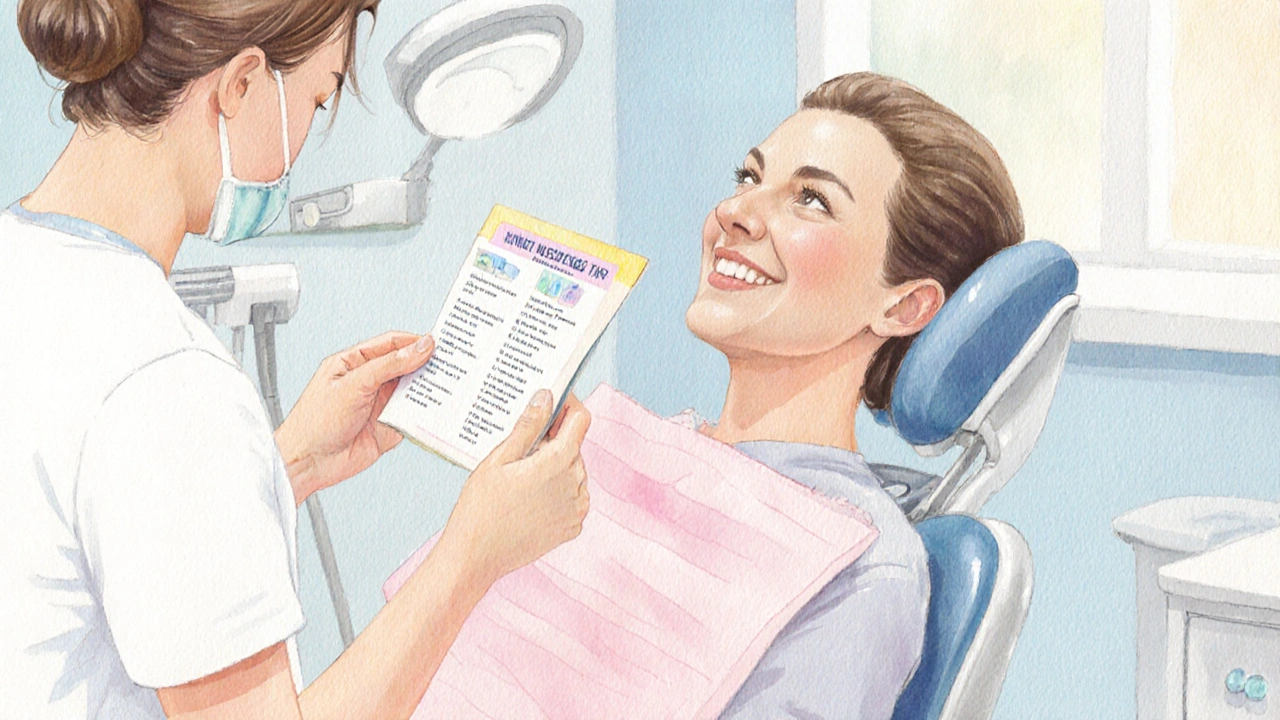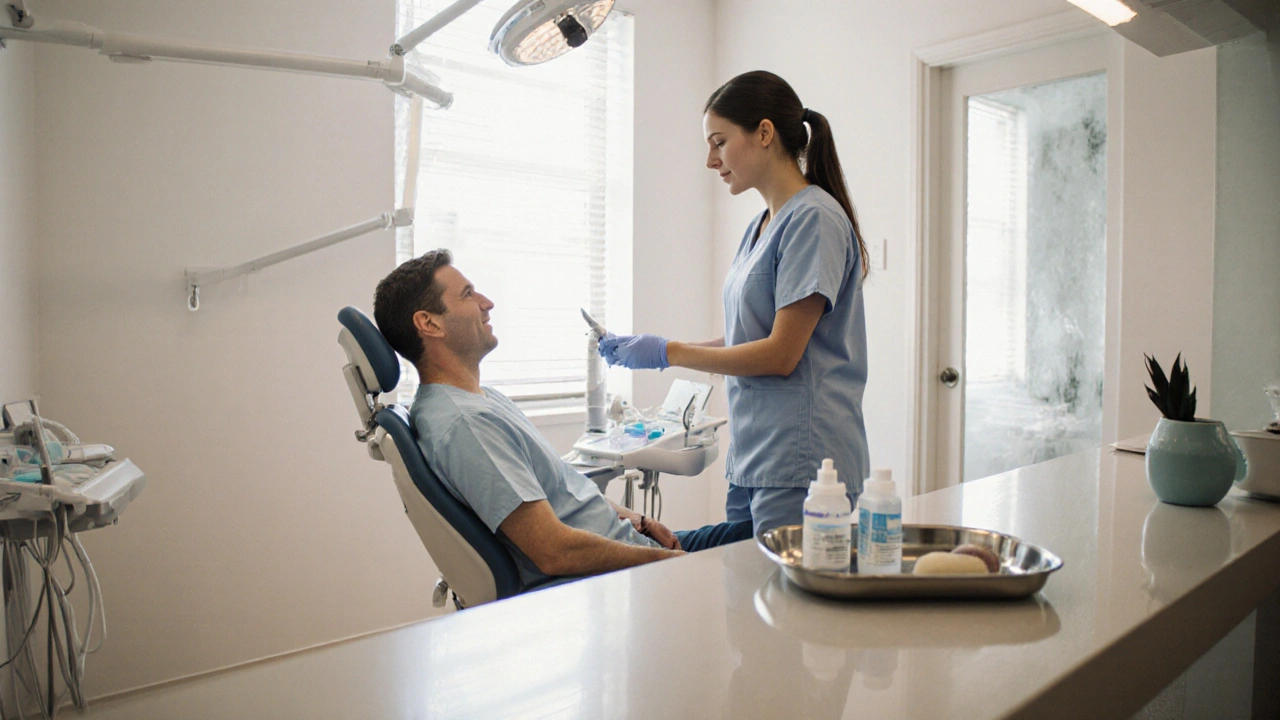Dental Prophylaxis Guide
What Is Dental Prophylaxis?
A preventive dental cleaning that removes plaque, tartar, and surface stains to maintain oral health and prevent gum disease.
Why It Matters
Reduces risk of gum disease, cavities, and bad breath while maintaining overall oral health.
Steps Involved in Prophylaxis
Scaling
Removes plaque and tartar using ultrasonic or hand instruments.
Polishing
Applies a gritty paste to smooth enamel and remove surface stains.
Fluoride Treatment (Optional)
Strengthens enamel and reduces decay risk with fluoride gel or varnish.
Benefits You'll Notice
Reduced Plaque
Less visible plaque on the gum line after cleaning.
Brighter Teeth
Stain removal leaves teeth looking cleaner and whiter.
Less Gum Bleeding
Improved gum health reduces bleeding during flossing.
Typical Costs in the UK
| Aspect | Dental Prophylaxis (NHS/Private) | Standard Cleaning (Private) |
|---|---|---|
| Frequency Recommended | Every 1-2 years (low risk) or 3-4 times per year (high risk) | Every 6-12 months |
| Procedure Depth | Scaling, polishing, optional fluoride | Scaling & polishing (no fluoride) |
| Typical Cost (Private) | £70-£120 | £45-£80 |
| Coverage (NHS) | Free for eligible adults (up to 2-year interval) | Usually not covered unless clinical need |
Frequently Asked Questions
Is dental prophylaxis painful?
Most patients feel only a mild scraping sensation. If you have sensitive gums, let the hygienist know—they can adjust the pressure.
How often should I get a prophylaxis?
Low-risk adults usually every 24 months on the NHS. High-risk patients or those with a history of gum disease may need quarterly appointments.
Can I get prophylaxis if I have braces?
Yes, but the hygienist will use special tools to clean around brackets. Some orthodontic patients prefer a cleaning every three months.
Your Prophylaxis Plan
Based on your information, your next prophylaxis appointment should be scheduled according to your risk level:
- Low Risk: Every 24 months
- Medium Risk: Every 12 months
- High Risk: Every 3-4 months
Remember to brush twice daily with fluoride toothpaste and floss regularly for optimal results.
Key Takeaways
- Dental prophylaxis is a preventive cleaning that removes plaque and tartar before they cause damage.
- The appointment usually lasts 30‑45 minutes and involves scaling, polishing, and sometimes fluoride.
- Expect a dental hygienist to guide you through each step, explain findings, and give personalized oral‑care tips.
- Regular prophylaxis reduces the risk of gum disease, cavities, and costly dental work.
- Post‑visit care includes brushing techniques, flossing advice, and possible follow‑up scheduling.
When you hear the term dental prophylaxis, you might picture a complicated procedure. In reality, it’s a straightforward, painless cleaning designed to keep your mouth healthy. Below, we break down exactly what to expect so you can walk into the dentist’s chair with confidence.
Dental prophylaxis is a preventive dental cleaning that removes plaque, tartar, and surface stains to maintain oral health and prevent gum disease. It differs from deep‑scale procedures used to treat existing disease, focusing instead on upkeep.
Dental hygienist is a licensed oral‑health professional who performs cleanings, educates patients, and assists dentists in preventing disease. In most UK practices, the hygienist leads the prophylaxis session while the dentist reviews findings.
What Exactly Is Dental Prophylaxis?
Dental prophylaxis involves three core actions:
- Scaling - Using ultrasonic or hand instruments to gently lift plaque and hardened tartar from the teeth’s surfaces.
- Polishing - Applying a gritty paste to smooth enamel, making it harder for plaque to stick.
- Fluoride treatment (optional) - Applying a fluoride gel or varnish to strengthen enamel and reduce decay risk.
Each step targets specific oral‑health threats.
Plaque is a soft, sticky film of bacteria that forms on teeth and feeds on sugars, producing acids that erode enamel. If left unchecked, plaque hardens into Tartar (calcified plaque that can only be removed with professional tools), which is a major cause of gum inflammation.

Why Regular Prophylaxis Matters
Consistent cleanings lower the odds of developing:
- Gum disease (inflammation of the gums that can progress from gingivitis to periodontitis)
- Cavities, because stronger enamel resists acid attacks.
- Bad breath, as bacterial buildup is a primary source.
In the UK, the NHS recommends a prophylaxis at least once every 24 months for low‑risk patients, while high‑risk individuals may need quarterly visits.
Step‑by‑Step: What Happens During Your Appointment
Knowing the flow helps you relax. Here’s a typical timeline:
- Check‑in and health review
- The receptionist confirms your details and medical history.
- The dental hygienist asks about recent pain, medication, or lifestyle changes.
- Initial oral exam
- The dentist or hygienist uses a small mirror to spot obvious issues.
- They may take a quick X‑ray if it’s been over two years.
\n - Scaling
- Ultrasonic scalers emit vibrations that break up tartar.
- Hand instruments smooth out any remaining spots.
- You’ll feel a mild scraping sensation, but it’s not painful.
- Polishing
- A rubber cup with polishing paste rubs the teeth, leaving a glossy finish.
- This step also removes superficial stains from coffee or tea.
- Fluoride application (optional)
- A thin layer of fluoride gel is painted on and left for a minute.
- You’ll be asked not to eat or drink for 30 minutes afterwards.
- Personalized care plan
- The hygienist discusses brushing technique, flossing tips, and any areas of concern.
- If cavities or gum issues are found, they’ll schedule a follow‑up.
The whole process typically lasts 30‑45 minutes, depending on your oral‑health status.
Benefits You’ll Notice Right Away
After the cleaning, many patients report a fresh, smooth feeling. You may also see:
- Reduced plaque visible on the gum line.
- Brighter teeth from stain removal.
- Less gum bleeding during flossing.
These immediate cues reassure you that the appointment was effective.

Typical Costs in the UK
| Aspect | Dental Prophylaxis (NHS/Private) | Standard Cleaning (Private) |
|---|---|---|
| Frequency Recommended | Every 1‑2 years (low risk) or 3‑4 times per year (high risk) | Every 6‑12 months |
| Procedure Depth | Scaling, polishing, optional fluoride | Scaling & polishing (no fluoride) |
| Typical Cost (Private) | £70‑£120 | £45‑£80 |
| Coverage (NHS) | Free for eligible adults (up to 2‑year interval) | Usually not covered unless clinical need |
After Your Visit: Home Care Tips
Keeping the benefits lasting is simple if you follow these habits:
- Brush twice daily with a fluoride toothpaste.
- Floss at least once; consider interdental brushes if you have tight spaces.
- Limit sugary snacks and acidic drinks; rinse with water after consumption.
- Schedule your next prophylaxis based on the risk level discussed.
If you experience sensitivity after polishing, a desensitizing toothpaste can help. Persistent bleeding or pain should be reported promptly.
Frequently Asked Questions
Is dental prophylaxis painful?
Most patients feel only a mild scraping sensation. If you have sensitive gums, let the hygienist know- they can adjust the pressure.
How often should I get a prophylaxis?
Low‑risk adults usually every 24 months on the NHS. High‑risk patients or those with a history of gum disease may need quarterly appointments.
Can I get prophylaxis if I have braces?
Yes, but the hygienist will use special tools to clean around brackets. Some orthodontic patients prefer a cleaning every three months.
What’s the difference between prophylaxis and deep cleaning?
Prophylaxis is preventive-removing surface plaque and tartar. Deep cleaning (scaling and root planing) targets bacteria below the gum line and is used to treat periodontitis.
Will I need a follow‑up after the cleaning?
If the hygienist spots early decay or gum inflammation, they’ll recommend a follow‑up. Otherwise, you’ll schedule your next routine prophylaxis.


Joanne Clark
October 9, 2025 AT 23:42Honestly, the whole scaling‑polishing routine is basically the gold‑standard for keeping your gums in tip‑top shape. The ultrasonic scaler takes out the nasty tartar that your toothbrush can’t reach and the polishing paste leaves your enamel with a glossy finish you’ll actually notice. If you’re lucky enough to get the optional fluoride, it’s like a protective shield against decay. So, think of it as a spa day for your teeth, just with less candles and more suction, definately worth the time.
Dan Barreto da Silva
October 9, 2025 AT 23:58Whoa – stepping into that dentist chair can feel like walking into a horror movie set, especially when the hygienist whirs that ultrasonic thing like a rocket launch. The scraping sensation is nothing compared to the drama of hearing that “we’ve got some tartar buildup!” echo through the room. But once the scaling is done you’ll walk out with a grin that could rival any movie star’s close‑up. Trust me, the after‑glow is the real plot twist.
Ariel Munoz
October 10, 2025 AT 00:15As a proud American who’s seen the worst of dental neglect, I can tell you that regular prophylaxis is a cornerstone of our nation’s health strategy. Scaling removes plaque that harbors the bacteria that cause cavities, and polishing smooths the enamel so acids have nowhere to cling. The optional fluoride treatment adds an extra layer of defense, much like a shield for the home front. Skipping these appointments is practically treason against your own smile.
Sriram K
October 10, 2025 AT 00:32Hey Dan, I get the drama vibe, but the hygienist will actually adjust the pressure if you let them know you’re sensitive. A quick heads‑up usually turns that “rocket launch” into a gentle breeze and you’ll still walk out with the same fresh feeling.
jess belcher
October 10, 2025 AT 00:48Scaling gets rid of hardened tartar while polishing smooths the surface and a fluoride coat adds extra protection
Maud Pauwels
October 10, 2025 AT 01:05Thanks for the clear breakdown that helps anyone reading feel less intimidated about the steps
Deborah Summerfelt
October 10, 2025 AT 01:22Everyone acts like prophylaxis is just a routine, yet it’s really a ritual that mirrors life’s constant battle against unseen decay. While some claim it’s painless, the subtle scrape reminds us that even comfort comes with a hint of discomfort, a truth we often overlook in our pursuit of a spotless smile.
Scott Richardson
October 10, 2025 AT 01:38If you skip your cleaning you’re just asking for trouble later.
Laurie Princiotto
October 10, 2025 AT 01:55That’s harsh but true 😅 skipping it is basically inviting cavities to throw a party in your mouth.
Justin Atkins
October 10, 2025 AT 02:12Undoubtedly, the prophylactic procedure constitutes a triad of meticulously orchestrated actions-scaling, polishing, and, when indicated, fluoride application-each synergistically contributing to the preservation of enamel integrity and periodontal health. By excising supragingival calculus, the hygienist not only mitigates the bacterial load but also facilitates a smoother substrate for subsequent polishing, thereby enhancing the aesthetic gleam of dentition.
June Wx
October 10, 2025 AT 02:28Yo, I always thought the dentist was just about fixing cavities, but the cleaning actually makes my mouth feel like it’s on a fresh start, like hitting the reset button for my whole day.
kristina b
October 10, 2025 AT 02:45In the grand tapestry of oral health, dental prophylaxis occupies a venerable position, as it is not merely a mechanical removal of debris but a ceremonial affirmation of one’s commitment to physiological stewardship. The procedure commences with a comprehensive intake wherein the hygienist assesses systemic conditions that may influence periodontal stability, thereby tailoring the ensuing interventions with scientific precision. Following this, the ultrasonic scaler, an instrument of both power and finesse, emits high‑frequency vibrations that dislodge calcified tartar adhering to the subgingival zones-areas the humble toothbrush can scarcely envisage. As each crest of calculus is meticulously eradicated, the patient experiences a subtle yet discernible alteration in the tactile landscape of their gums, a sensation akin to the first breath of spring after a prolonged winter. The subsequent polishing phase, wherein a rubber cup bearing a mildly abrasive paste glides across enamel, serves not only an aesthetic function but also a protective one; the resultant micro‑smoothness diminishes plaque adherence, thereby thwarting bacterial colonization at its incipient stage. When deemed appropriate, a fluoride varnish or gel is applied, delivering calcium‑fluoride complexes that infiltrate enamel porosities, reinforcing the crystalline lattice and augmenting resistance to acidogenic attacks. The duration of the entire encounter seldom exceeds forty‑five minutes, a temporal investment that yields dividends spanning months, if not years, of diminished carious activity. Moreover, the patient departs with a personalized oral‑care regimen-a suite of brushing techniques, flossing recommendations, and dietary counsel-that empowers sustained prophylactic vigilance. Such individualized guidance fosters adherence, as patients are more inclined to follow recommendations that resonate with their unique oral architecture. Consequently, the cumulative effect of periodic cleanings extends beyond the oral cavity, influencing systemic biomarkers of health. It is imperative to acknowledge that while the tactile sensations may be benign, the psychological reassurance conferred by a clean, polished dentition cannot be understated; confidence in one’s smile often translates into broader social and professional fortitude. From an epidemiological perspective, regular prophylaxis correlates inversely with the prevalence of gingivitis and periodontitis, underscoring its role as a preventative bulwark against systemic inflammation. The fiscal implications are equally salient, for averting advanced disease curtails the necessity for costly restorative procedures, thereby alleviating economic burdens on both patients and healthcare systems. In sum, dental prophylaxis epitomizes an intersection of clinical expertise, patient education, and preventative strategy, each component harmonizing to safeguard oral integrity. Therefore, embracing scheduled cleanings is not an act of vanity but a judicious investment in lifelong health.
Ida Sakina
October 10, 2025 AT 03:02One must view dental prophylaxis not merely as a personal indulgence but as a civic duty to maintain public health standards.
Amreesh Tyagi
October 10, 2025 AT 03:18Skipping a cleaning is just lazy procrastination.
Brianna Valido
October 10, 2025 AT 03:35Keep up with your cleanings and watch your smile shine brighter every day! 😁✨🦷
Caitlin Downing
October 10, 2025 AT 03:52Wow kristina, that was a marathon of info-definitely felt like a lecture in a dental school hallway. I love how you linked the quick appointment time to long‑term savings, it really hits home. The bit about confidence boosting was spot on; a bright smile does wonders for mood. Great job breaking down the science without drowning us in jargon. Thanks for the thorough rundown!
Robert Jaskowiak
October 10, 2025 AT 04:08Oh sure, because spending half an hour getting scraped feels way more fun than binge‑watching a whole season of a show, right?
Julia Gonchar
October 10, 2025 AT 04:25Just so you know, most dentists recommend the fluoride step only if you have a history of cavities, otherwise it’s optional.
Annie Crumbaugh
October 10, 2025 AT 04:42Anyway, regular cleanings keep my teeth feeling fresh without any drama.